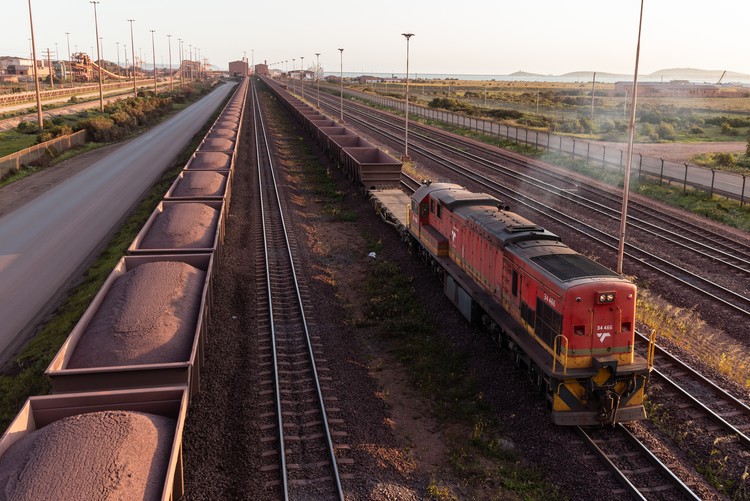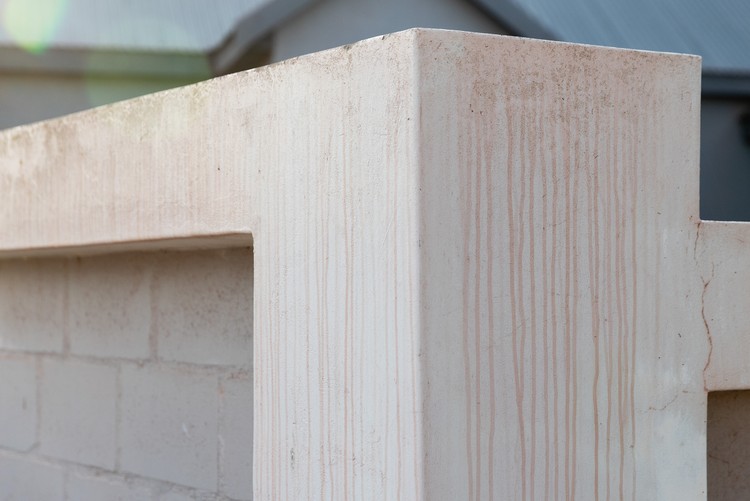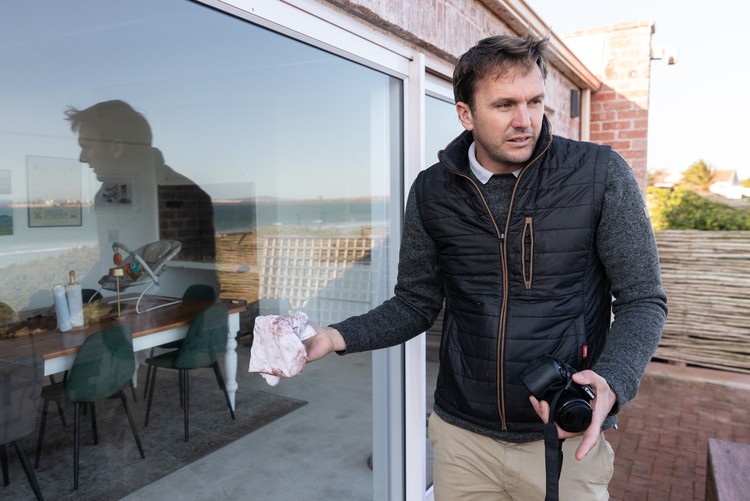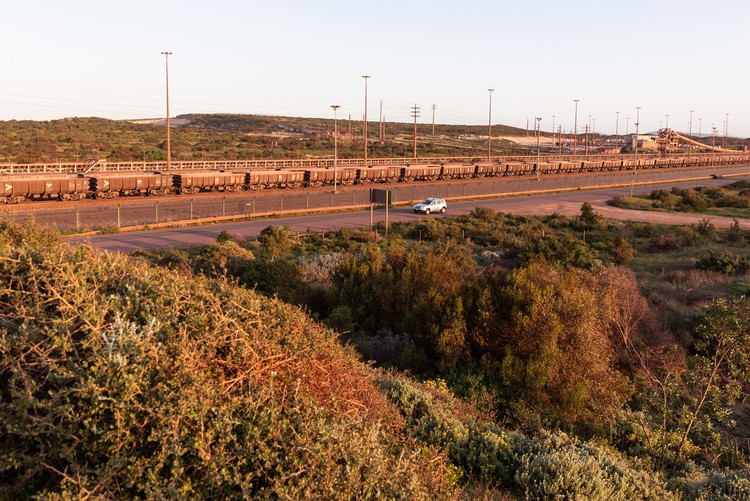Rooigevaar in Saldanha: residents say red dust from Transnet’s ore terminal is staining their homes and even their dogs
But Transnet says the dust falls below legal limits
Iron ore is transported to the Transnet port terminal by rail from Sishen in the Northern Cape.
- Residents of Saldanha Bay and nearby Vredenburg say red dust pollution from the Transnet Port Terminal, through which iron ore is exported, is staining their homes, cars, trees, roads and even pets.
- Transnet says the dust emissions fall far below allowed limits.
- Residents of Saldanha Bay, Vredenburg, and Langebaan have formed a group to look into dust legislation and demand changes.
Driving through Saldanha Bay and nearby Vredenburg, you will see roads, houses, signs, trees, and cars stained red. The red dust comes from the Transnet Port Terminal, where iron ore from the mines in the Northern Cape is loaded onto ships in the Saldanha Bay port for export.
The Saldanha terminal started operating in the 1970s and, according to Transnet, is the largest exporter of iron ore in Africa. The iron ore is transported by train on an 861 km-long Sishen-Saldanha railway line from the Sishen mine in the Northern Cape close to Kathu all the way to the Saldanha port.
According to Transnet, an average of 58-million tonnes of iron ore is railed every year to Saldhana for export. The Transnet terminal also handles smaller amounts of other commodities including manganese, zinc, and lead.
Transnet has taken steps to minimise dust during offloading and on its conveyor belt, and says dust levels are below legal maximum levels. But residents say the red dust is still a serious problem.
Fed up residents have formed the Red Dust Action Group (RDAG). The association, which has about 1,000 members on Facebook, is “advocating for a clean and sustainable port of Saldanha and its surrounding communities”.
On the Facebook page, residents share photos of red dust plumes around the Transnet terminal, or red dust staining their walls and gutters of their homes, and their cars.
Residents frequently have to wash down and repaint their homes because of the stains.
Measurements taken by Saldanha Bay Municipality and shared publicly show dust emissions within the national limits.
But Kyle Dods, chairperson of RDAG, said the association intends to take its own measurements. He said RDAG also wants more public participation on the issue and a better complaints process.
The association also intends to make suggestions about legislation on dust emissions, specifically the National Environmental Management Act (NEMA) and the Air Quality Act.
Kyle Dods, chairperson of the Red Dust Action Group, wipes the red dust from the window sill of his home in Bluewater Bay.
Dods said the red dust has a massive effect on the way people live.
“People are incredibly stressed and angry in this area … You can’t hang your washing outside. Your dogs go outside and they come back inside covered in iron ore dust,” he said.
He said that when people leave doors open, kitchen surfaces are stained in red dust, buildings need to be repainted frequently and signs need to be replaced.
The dust was “incredibly penetrative”, he said. “When it lands on a surface it doesn’t just wash off, it penetrates into that surface … If you have any kind of business, it’s going to penetrate into the surfaces of your business. Gutter system, signage, your car … It excludes a large amount of businesses from operating in the area.”
Red dust can be seen staining the beach at Blue Water Bay opposite the terminal.
Saldanha Bay resident Este Noble said he and a few other residents had signed agreements with Transnet in 2018 and had been compensated for staining at their houses. Noble had sprayed his house and repainted it. After that, he said, he had expected the pollution to decrease, but it had continued.
He said he had phoned Transnet after a particularly bad incident of pollution this year at his house in Bluewater Bay in Saldanha. “From Transnet’s side, they say according to their records there wasn’t a release. But I and the people around me, we have red houses, and our dogs are red, and everything is red. I had to wash everything down,” said Noble.
Transnet’s response
Andiswa Mesatywa, Regional Corporate Affairs and Stakeholder Manager at Transnet, told GroundUp that Transnet used several dust suppression measures to limit the red dust at the terminal.
The terminal had invested in a “reverse osmosis plant” that desalinates seawater to use it in dust control.
Transnet had installed water points in front of the tipplers used to offload the ore, to wet it, used chemical dosing on conveyor belts to subdue the dust, and also used “dust extraction plants” to remove dust while offloading the ore.
Mesatywa said dust emission levels are monitored by an independent environmental consultant, and had been below the emissions limits “for decades”. Asked by GroundUp for the measurements, Transnet said a request must be submitted in compliance with the POPI Act.
“While there may be visible nuisance dust in some parts of Saldanha closest to the terminal’s operations, this poses no health threats,” he said. Mesatywa said there were regular meetings with the community on the issue.
A car drives through a landscape filled with red.
Sinah Phochana, spokesperson for Kumba Iron Ore, which owns the Sishen mine, said Kumba worked closely with Transnet to “mitigate the dust impact”. “
At Kumba’s operations, Sishen and Kolomela, dust suppression systems at our plants and load out stations are in place when trains are loaded before departure,” said Phochana.
Saldanha Bay Municipality spokesperson Tereza Burger said the municipality “typically receives complaints during the windy months (October to April) when the predominant southerly winds are very strong” and minimal complaints during the winter season. The complaints are sent to West Coast District Municipality (WCDM) as the licensing authority and to Transnet Port Terminals.
Support independent journalism
Donate using Payfast

Next: Hundreds of drug users stranded after Gauteng government closes rehabs
Previous: The public swimming pool in this Eastern Cape town has been empty for four years
Letters
Dear Editor
A desperate plea to those in positions of power to save this area from a severe and deadly problem affecting our people, plants and animals. I lived in this area during the 1980s when it was one of the most beautiful, clean-air regions on the West Coast. I returned 20 years ago to a shocking pink landscape posing a health hazard to both people and animals. Please, save this area from total destruction. Thank you in advance.
Dear Editor
This is a huge problem and really needs to be looked at or revisited. Transnet must be responsible for repainting people's houses every three years! As if it’s legal. Someone must be responsible! Why is it always the man on the street who has no say in what municipalities keep allowing? I don’t believe this is within acceptable limits – it’s way over! Here in Shelley Point, everyone’s houses go pink! It’s terrible!
Dear Editor
I have now written to Transnet for the second time this year after repainting my house, and I really hope they will address the red dust emissions. If we stay silent, they won’t take any action. I have many photos showing the red dust damage at my house.
Dear Editor
I reside in Langebaan and we even have signs of the red dust around our property. We moved into our current house two years ago. Sometimes, when it is really windy, you can smell something is off outside. I have also been struggling with asthma and severe sinus issues, which really makes me think that it is a result of the red dust. Just looking at Saldanha, the amount of red dust in the air looks excessive. They have to do better. Not only humans, but the whole environment is affected by this and it is unacceptable.
© 2024 GroundUp. This article is licensed under a Creative Commons Attribution-NoDerivatives 4.0 International License.
You may republish this article, so long as you credit the authors and GroundUp, and do not change the text. Please include a link back to the original article.
We put an invisible pixel in the article so that we can count traffic to republishers. All analytics tools are solely on our servers. We do not give our logs to any third party. Logs are deleted after two weeks. We do not use any IP address identifying information except to count regional traffic. We are solely interested in counting hits, not tracking users. If you republish, please do not delete the invisible pixel.





